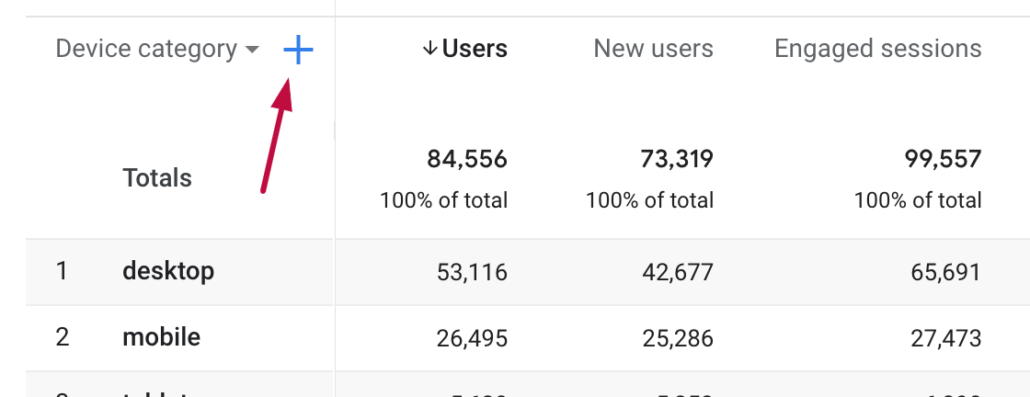Transform Your Analytics Approach With Secondary Dimension in Google Analytics
By incorporating additional dimensions into information analysis, a brand-new layer of insights emerges, losing light on complex user behaviors and communications. The calculated application of secondary dimensions holds the vital to opening a treasure trove of very useful info that can revolutionize just how organizations analyze and act upon their data.
Recognizing Second Dimensions in Google Analytics
Additional dimensions in Google Analytics give extra context to primary information by enabling customers to assess metrics across a 2nd dimension, using deeper insights right into user habits and communications on a web site. Secondary Dimension in Google Analytics. While key dimensions give essential information factors such as pageviews, bounce price, and session period, secondary dimensions use an even more detailed view by segmenting the key data even more. This division allows individuals to analyze metrics in mix with an additional dimension, such as web traffic resources, demographics, or user actions
Benefits of Making Use Of Second Measurements
Utilizing second measurements in Google Analytics offers a strategic benefit by enhancing the depth of evaluation and offering a more extensive understanding of user interactions and habits on a website. By including secondary dimensions, experts can get useful insights right into the efficiency of certain sectors or variables within their data. This makes it possible for a much more in-depth evaluation of customer behavior past surface-level metrics, enabling for a much deeper exploration of the elements affecting customer engagement and conversions.

Exactly How to Execute Second Measurements
When integrating secondary measurements in Google Analytics, one necessary step is to pick the relevant metrics and measurements to improve the analysis process. Clicking on this switch will open a drop-down food selection listing different measurements that can be included to your key measurement for deeper insights.
After picking the suitable additional dimension, such as 'Source/Medium' or 'Gadget Category,' Google Analytics will show the information in a more in-depth layout, permitting you to cross-analyze various aspects of individual actions. Remember to explore various combinations of second and main measurements to uncover important patterns and fads that can inform your advertising approaches. By applying additional measurements thoughtfully, you can get an extra detailed understanding of your website or app efficiency and make data-driven decisions to enhance your electronic visibility.
Studying Information With Additional Measurements
Improve your data evaluation in Google Analytics by including additional dimensions to dive much deeper into customer habits patterns and optimize your digital advertising and marketing methods successfully - Secondary Dimension in Google Analytics. By adding second measurements to your primary data, you can obtain useful insights that can assist you make educated decisions about your internet site or app efficiency
Examining data with secondary measurements allows you to sector your main information additionally, offering an extra extensive sight of individual interactions. For circumstances, integrating the primary measurement of 'source/medium' with a secondary measurement like 'landing web page' can expose which details pages are driving website traffic from different resources. This information can be critical in refining your web content technique or maximizing your ad campaign to raise conversions.
Moreover, utilizing second measurements enables you to recognize relationships between various metrics, resource assisting you understand the influence of numerous aspects on user actions. Whether it's evaluating demographics alongside customer engagement metrics or tool groups with conversion prices, additional dimensions equip you to uncover hidden fads and patterns that can assist your advertising efforts.
Optimizing Performance With Secondary Measurements
To boost the performance of data analysis and decision-making in Google Analytics, integrating additional measurements is crucial to enhancing performance metrics and obtaining deeper understandings into customer habits patterns. By utilizing additional dimensions, experts can dig beyond surface-level information and uncover useful correlations that might otherwise go undetected. This optimization technique enables organizations to tailor their advertising efforts much more properly, identify areas for renovation in site use, and enhance total user experience.
Additional dimensions use a more extensive sight of user communications by giving additional context to main data metrics. Matching the key measurement of 'landing web page' with a secondary measurement like 'gadget group' can reveal whether particular devices are extra likely to drive engagement on certain landing web pages. This insight can educate responsive layout renovations or targeted marketing methods to increase performance.

Verdict
To conclude, the integration of secondary dimensions in Google Analytics supplies companies with a powerful device to enhance Homepage their analytics approach. Secondary Dimension in Google Analytics. By diving deeper into customer habits and communications, marketing experts can discover important insights that can drive efficiency optimization and enhance the overall customer experience. Leveraging second dimensions enables an extra extensive evaluation of data, leading to even more informed decision-making and customized marketing initiatives
Secondary measurements in Google Analytics give extra context to primary information by enabling users to analyze metrics across a second measurement, using deeper insights into customer actions and communications on an internet site. While primary dimensions give fundamental information points such as pageviews, bounce price, and session duration, second dimensions offer an even more thorough sight by segmenting the key information even more.One of the essential advantages of utilizing additional measurements is the ability to uncover relationships and patterns that might not be instantly evident when examining data with key dimensions alone.When incorporating second dimensions in Google Analytics, one essential action is to choose the relevant metrics and measurements to enhance the analysis process. Pairing the primary measurement click for info of 'landing web page' with a secondary measurement like 'tool classification' can expose whether specific devices are a lot more most likely to drive involvement on particular landing web pages.